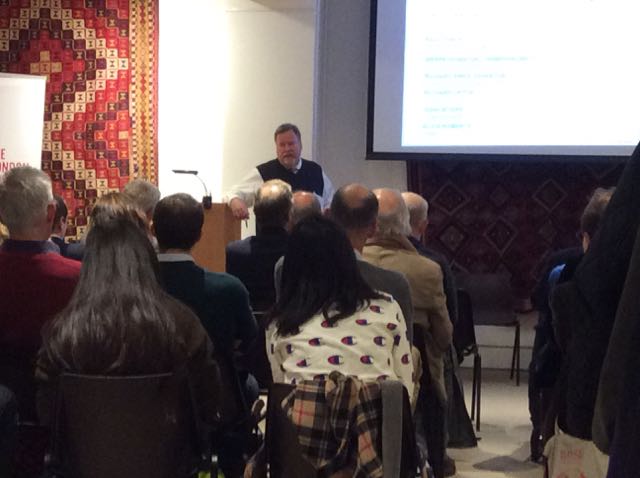Post
REPORT | The London Society Green Belt Debate
15 May 2017
Passions run high on all sides in discussions about the future of the Green Belt, but this often produces more heat than light. This London Society Debate: A Better Green Belt? Making the Green Belt fit for the 21st Century brought together five speakers with differing views to give their opinions on what, if anything, should be done: Richard Knox Johnston, London Green Belt Council; Richard Upton, Deputy Chief Executive U+I plc; Merrick Denton-Thompson, the Landscape Institute; John Myers, London YIMBY and Alice Roberts of the CPRE. Paul Finch of Architects' Journal chaired the discussion, and Saul Collyns reports.
The green belt tends to provoke passionate debate amongst Londoners, and this was no less true at the London Society debate. Nevertheless, ever keen to move discussions forward (London Society played an instrumental role advocating for its creation in the 1930s), this event aimed to move beyond binary discussions with speakers characterised as ‘for’ or ‘against’, to explore how it can be made fit for the 21st century.
Five speakers covering a range of opinions were invited to present their case. First up was Merrick Denton Thompson, President of Landscape Institute, who argued for a strategic review of the green belt. He argued that its original intention to protect cities from urban sprawl has never been more critical, yet a vacuum in strategic planning has led to incoherent policy; for example there was initially no designated green belt in Hampshire. A review would identify places where new green belt is needed (such as to prevent sprawl in Southampton and Portsmouth from merging the cities), but he also argued for management plans that move away from single issue designations. Denton Thompson believes this would help restore the landscape of the green belt, and make cities more resilient to climate change.
Richard Knox-Johnston, Chair of London Green Belt Council, stressed that London's green belt is under threat when there is no need for it to be. He argued that the green belt is not responsible for London’s housing crisis, whereas the practice of land sitting by housing developers is a serious impediment. For example, Ebbsfleet Garden City received planning permission in 2007 yet only 150 homes had been built by the end of 2016. What’s more, he argued that new housing in London is not built at high enough density to alleviate the shortage. Knox-Johnston underlined the immense benefits that the green belt brings to London, such as enhanced biodiversity, a reduced risk of flooding and recreational activities. The green belt should be made more attractive and accessible so that more of us can profit from it, and to spur more regeneration within London to provide the housing the city needs.
In contrast, Richard Upton, Deputy Chief Executive of housing developer u+i, called for an army of progressives to march onto the green belt and replace it with something more relevant. He expressed dismay that the Housing white paper devotes little space to how building on the green belt could help fix broken housing markets, due in large part to weak politicians that avoid difficult questions. He believes that the tall towers that are rising above London destroy the spirit of the city, do not provide the homes that Londoners want, and do little to solve the housing crisis. By building on the many golf courses and strip clubs on the green belt we could build more affordable housing for Londoner’s, thus driving the city’s economy.
John Myers co-founded London YIMBY, which campaigns for development in people’s ‘back yards’ as a means of providing more homes. Myers argued that as much of London is characterised by low-rise housing of one or two storeys, there is potential to build on top of it, creating 5 storey terrace housing akin to neighbourhoods such as Clerkenwell and Pimlico. This would increase housing provision without needing to build on the green belt, and in the process decent streets could be transformed into more walkable streets. Myers advocated that such projects can achieve buy-in from communities if done properly; and he suggested that residents in a street should have control over the process, choosing their own design codes.
Last to speak was Alice Roberts, Director of CPRE London. Like Knox-Johnston she argued that building on the green belt would be pointless and wouldn’t solve London’s housing crisis. She believes it can only be solved if the cost of housing is brought down, and increasing supply doesn’t always solve affordability issues; especially as development on the green belt tends to be high-value. She agreed that land sitting is an issue, and advocated marching into Ebbsfleet instead. Roberts argued that brownfield sites contain the potential to accommodate 10 million homes in London, and opportunities for intensification are immense. By way of example she showed many schemes from the borough of Hackney, where housing has been built on top of commercial space.
Despite the strength of the different arguments made during the debate, Chair Paul Finch (Editorial Director, Architects Journal) summarised well by highlighting the commonality of many of the views expressed. He ended by offering his own take: London’s housing crisis has come about simply due to the fact that we stopped building homes in the 1980s, when the city’s population was growing. He noted that politicians like to blame the planning system for such failures when the very same politicians are those who can alter it to increase supply, so changing the political agenda would be a good start.
See also the London Society's White Paper, Green Sprawl - our Current Affection for a Preservation Myth, available to download free.
